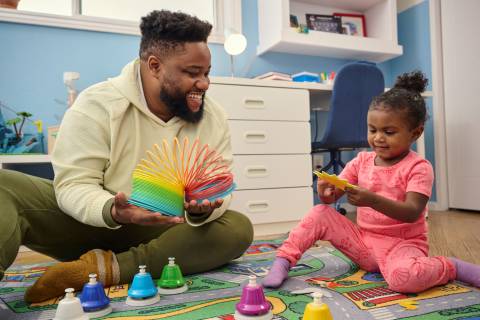One minute, your child might be leaping through the air, exclaiming they’re a bird with the biggest wings in the world. The next moment, they could be galloping down the hallway and neighing like a horse. And all of this make-believe play is helping with their development!

Playing make-believe is when children use their imagination to pretend they are different characters or in various situations, often acting out stories and scenarios. This type of play benefits your child in many different ways:
Boosts brain development: Make-believe play encourages creativity and imaginative thinking. When they use their imagination to create stories, they train their brains to think more broadly and develop new ideas. This playful activity also helps improve memory and concentration as they remember and act out different scenes and roles.
Builds language and communication skills: Through make-believe play, children practice verbal communication by making up dialogue and expressing their imagination. They also develop nonverbal communication skills, such as facial expressions and body language, to show emotions.
Helps with social and emotional development: Pretend play provides opportunities for children to interact with others, talk about their different roles in the story, share ideas, and work together. They learn about empathy, cooperation, and taking turns, which promote social skills and emotional intelligence. They’re able to express and explore different emotions in a safe and controlled environment.
Challenges them to solve problems and make decisions: When children engage in make-believe scenarios, they encounter various challenges and dilemmas that require problem-solving and decision-making skills. They learn to think creatively, adapt to changing circumstances, and find solutions within the imaginative context they created.
Increases self-confidence and self-identity: By trying on different roles and pretending to be different characters, children develop a sense of self-identity and gain confidence in expressing themselves. They learn about themselves and their strengths and interests.
Builds fine and gross motor skills: Imaginative play often involves physical movements and actions, which help children develop fine motor and gross motor skills. Children enhance their coordination when they engage in activities like building, dressing up, and role-playing.
Playing make-believe with your child can be a great bonding experience and help spark your child’s imagination. Here are some tips to get started:
Follow their lead: Observe what interests your child and join in their play based on their current imagination. If they’re pretending to be a superhero, you can become their sidekick or create a villain for them to defeat.
Provide props and costumes: Some caregivers like to keep a box of simple props and costumes, such as hats, scarves, or toy food, that can be used to enhance the imaginative play experience. These items can help spark their creativity and make the play more immersive.
Ask open-ended questions: Encourage your child’s imagination by asking open-ended questions that prompt them to think creatively. For example, “What do you think would happen if we lived on a pirate ship? What would we do?” Try using the improvisation rule of “Yes, and.” For example, your child might say that they’re saving a fairy princess from an evil witch. To encourage the story, try saying, “Yes! And how do we get to the fairy princess?”
Create a playful environment: Designate a space in your home where imaginative play can happen without interruption. Set up a play corner with a few toys and materials that inspire pretend play, such as a dollhouse, blocks, or dress-up clothes.
Be a playful participant: Actively engage in the make-believe play alongside your child. Take on roles, use different voices, and get involved in the imaginary world. This shows that you value their play and encourages them to keep developing the story.
Draw from characters in your child’s favorite books and TV shows: Use storybooks or age-appropriate TV shows as a starting point for imaginative play. After reading a book or watching a show, encourage your child to reenact their favorite parts or create new stories based on the characters.
The focus is on encouraging creativity, having fun, and bonding with your child. As much as possible, embrace your own imagination during playtime and be silly.








